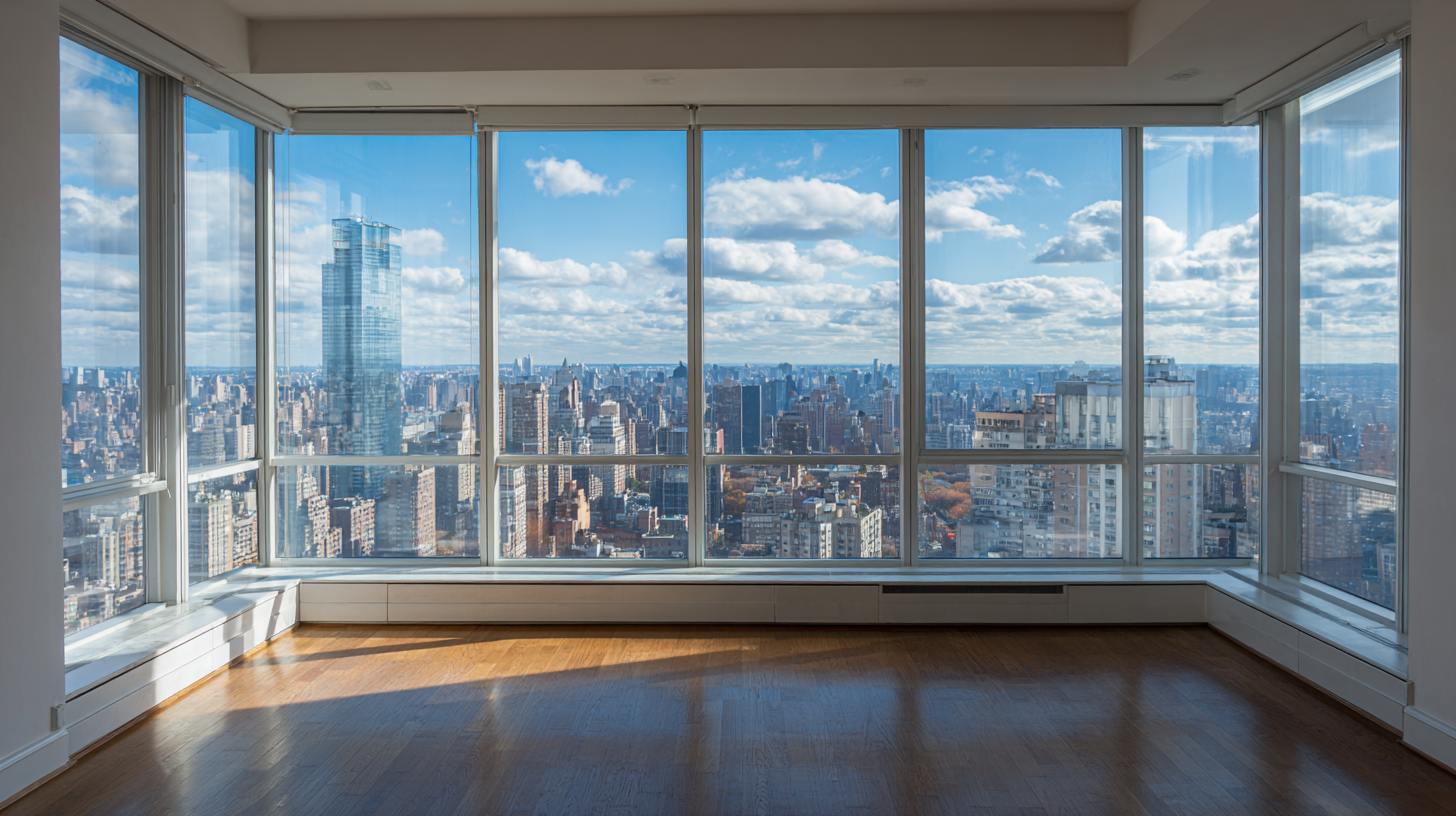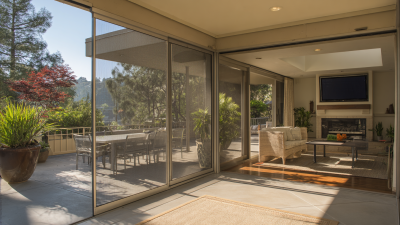Exploring the Impact of Window Places on Indoor Air Quality: A Comprehensive Review
The role of "window places" in influencing indoor air quality has garnered considerable attention in recent research, as indoor environments have been linked to various health outcomes. According to the World Health Organization, indoor air pollution accounts for approximately 4.3 million deaths annually, highlighting the critical need for effective management of indoor air quality (IAQ). A comprehensive review of existing literature indicates that the placement and design of windows significantly impact ventilation rates, allowing for better outdoor air exchange and the reduction of indoor pollutants.

Studies show that well-designed window places can enhance airflow and contribute to the dilution of harmful substances within the indoor environment. For instance, a report by the U.S. Environmental Protection Agency suggests that increasing natural ventilation through window placements can lead to a 30% reduction in indoor contaminants. Understanding the dynamics of window places not only serves to improve air quality but also enhances occupant comfort and wellbeing in various building settings.
Assessing the Role of Window Placement in Enhancing Ventilation Efficiency
The placement of windows in indoor environments significantly influences ventilation efficiency, which is crucial for maintaining optimal indoor air quality (IAQ). Research indicates that natural ventilation, facilitated by strategically placed windows, can effectively mitigate airborne transmission of respiratory pathogens, a pressing global health challenge. For instance, a recent study emphasizes the importance of window design in educational buildings, where natural ventilation is pivotal to achieving thermal comfort and improved air quality. Evidence shows that enhancing natural airflow can lower the concentration of indoor pollutants, ultimately benefiting occupant health and productivity.
**Tips:** When designing spaces, consider the orientation and size of windows to optimize natural airflow. For maximum efficiency, incorporate adjustable window features that allow occupants to control ventilation based on real-time needs.
Furthermore, advancements in window technology, such as the Acoustic Metawindow, showcase innovative solutions that combine sound insulation with natural ventilation capabilities. These developments not only enhance the auditory comfort within spaces but also ensure adequate airflow, thus supporting healthier indoor environments. In high-rise buildings, for example, specific envelope designs have been identified as viable for natural ventilation strategies, resulting in improved comfort and energy performance.
**Tips:** Regularly assess and adapt window designs in existing buildings to maximize ventilation effectiveness and IAQ. Engaging with professionals for tailored solutions based on current standards can proactively address potential air quality issues.
Impact of Window Placement on Indoor Air Quality
Analyzing the Connection Between Natural Light and Indoor Air Quality
Natural light plays a pivotal role in enhancing indoor air quality, as it positively influences occupants' well-being and productivity. When windows are placed strategically to maximize sunlight exposure, they not only bring warmth and brightness into the space but also help regulate humidity levels and facilitate natural ventilation. The influx of fresh air and sunlight can significantly reduce indoor pollutants, thus creating a healthier environment for inhabitants.
Tips: To optimize the benefits of natural light, consider the orientation of your windows. East-facing windows can capture morning sunlight, while west-facing ones are ideal for late afternoon brightness. Incorporating operable windows allows fresh air to circulate, complementing the light’s impact on air quality.
Moreover, the interplay between natural light and air quality is essential for mental health and comfort. Spaces that utilize daylight effectively can enhance mood and reduce stress levels. Integrating plants near windows can further purify the air, taking advantage of both natural light and the inherent air-cleaning properties of greenery.
Tips: Use window treatments that allow light while maintaining privacy, such as sheer curtains or adjustable blinds. Additionally, ensure that windows are regularly cleaned to maximize light penetration and maintain an unobstructed view of the outdoors.
Evaluating Different Window Types and Their Impact on Pollutant Levels
The design and functionality of windows play a crucial role in determining indoor air quality (IAQ). Different window types, including casement, sliding, and fixed windows, have varied impacts on pollutant levels within indoor environments. According to a study published by the International Journal of Indoor Environment and Health, casement windows, which open outward, can significantly enhance ventilation compared to sliding windows. This improvement in air exchange is vital as it helps dilute indoor pollutants such as volatile organic compounds (VOCs) and particulate matter, which are commonly found in household items and cosmetics.
In a comprehensive review conducted by the U.S. Environmental Protection Agency (EPA), it was revealed that homes equipped with operable windows exhibited 30% lower levels of airborne toxins. Moreover, the positioning of windows also matters; south-facing windows allow for better sunlight penetration, which can additionally reduce the growth of mold and dust mites, thus improving overall air quality. With the average American spending 90% of their time indoors, choosing the right window type and placement becomes an essential strategy for enhancing IAQ, promoting health, and contributing to a more sustainable living environment.
Exploring the Impact of Window Places on Indoor Air Quality: A Comprehensive Review
| Window Type | Pollutant Levels (µg/m³) | Ventilation Rate (ACH) | Fresh Air Intake (l/s) | Energy Efficiency Ratings |
|---|---|---|---|---|
| Single-Hung Window | 30 | 0.5 | 5 | C |
| Double-Hung Window | 25 | 0.7 | 7 | B |
| Casement Window | 20 | 1.0 | 10 | A |
| Sliding Window | 35 | 0.6 | 6 | C |
| Awning Window | 15 | 0.8 | 9 | A+ |
Investigating Seasonal Variations in Air Quality Related to Window Orientation
Seasonal variations play a significant role in indoor air quality, particularly concerning window orientation. Research indicates that the direction in which windows face can significantly impact the concentration of pollutants and the influx of fresh air. For instance, a study published by the American Society of Heating, Refrigerating and Air-Conditioning Engineers (ASHRAE) highlights that south-facing windows allow for greater solar gain during winter months, potentially increasing indoor temperatures; however, they can also elevate levels of volatile organic compounds (VOCs) due to higher thermal loads. Conversely, north-facing windows tend to maintain cooler indoor conditions, which can lead to less fluctuation in humidity and subsequently reduced chances of mold growth, highlighting the importance of strategic window placement.

Moreover, seasonal weather patterns further compound these effects. According to the EPA's report on indoor air quality, outdoor air quality can fluctuate dramatically between seasons, leading to varying indoor conditions even with the same window orientations. For example, during spring and summer, increased pollen levels can pose a risk for those with allergies if windows are left open, while fall offers opportunities for ventilation with lower bacterial counts. Understanding these dynamics empowers architects and builders to design spaces that optimize natural ventilation while safeguarding occupants from seasonal air quality issues.
Recommendations for Optimizing Window Design to Improve Indoor Environments
The design of windows plays a critical role in determining indoor air quality (IAQ), which directly impacts our health and well-being. According to the World Health Organization (WHO), poor indoor air quality is linked to respiratory diseases and other health issues, significantly affecting productivity and quality of life. To mitigate these risks, it is essential to optimize window design to enhance ventilation and daylighting, thereby improving indoor environments.

One effective recommendation is to incorporate operable windows that facilitate natural ventilation. A study by the Environmental Protection Agency (EPA) highlights that homes with operable windows can achieve a 30-50% reduction in indoor air pollutants compared to those with fixed windows. Additionally, integrating technologies such as smart sensors can help monitor air quality and automatically adjust window openings based on real-time conditions. Furthermore, strategically positioning windows to utilize cross-ventilation can enhance airflow, reducing the buildup of pollutants and maintaining a healthier indoor atmosphere.
In addition to functionality, window materials and coatings can also contribute to better indoor air quality. Low-emissivity (low-E) coatings help regulate indoor temperatures while minimizing condensation, which is crucial for preventing mold growth. By prioritizing window design that promotes both natural light and air circulation, we can create indoor spaces that not only look appealing but also foster healthier living conditions.
Our Location
476 Main Street - Route 28
Dennisport, MA 02639
Business Hours -
- Mon - Fri
- -
- Saturday
- -
- Sunday
- Closed


Share On: